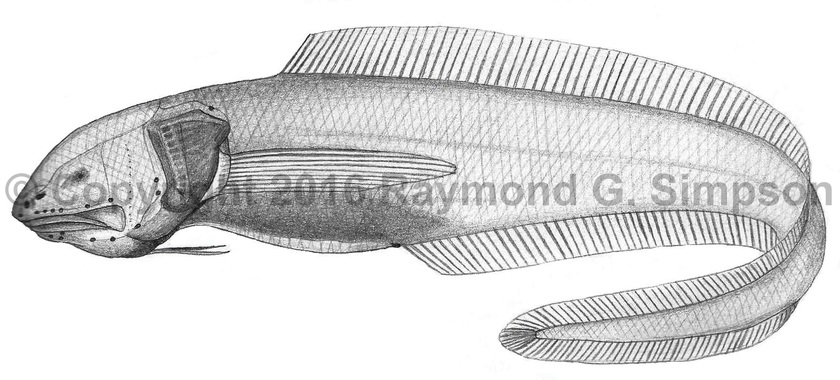
Common Name
Abyssal Brotula
Year Described
Nielsen, 1977
Identification
Dorsal Fin: 97-116
Anal Fin: 76-96
Pelvic Fin: 2
Pectoral Fin: 10-11
Caudal Fin: 8
Gill Rakers: 8-11 (only long rakers)
Branchiostegal Rays: 7-8
Vertebrae: 17-19 precaudal, 49-56 caudal vertebrae
Body elongated, soft, and eel-like. Skin transparent. Head with steeply sloped forehead and distinctly “kinked” downward. Snout bluntly pointed. Eye minute and buried in skin. Jaw extends well past posterior margin of orbit. Mouth inferior. Teeth present in jaws, on palatine, and on vomer. Basibranchial tooth patch paired on median. Vomerine teeth in chevron-shaped patch. Opercular spine weak. Dorsal and anal fins confluent with caudal fin. Pectoral fin large and long (reaches anal fin). Pelvic fin rays short. Lateral line only apparent anteriorly. Body scales easily shed.
Color
Skin transparent with pale musculature showing through. Branchial and gut regions black.
Size
Maximum size to 157mm SL
Habitat
One of the deepest of all living fishes: taken at hadal depths from 2500-8370m. The deepest of all specimens was taken in the Puerto Rican Trench.
Range
Occurs off the northeastern U.S., the Caribbean Sea, and the Puerto Rico Trench.
References
Nielsen, J. G. 1977. The deepest living fish Abyssobrotula galatheae. A new genus and species of oviparous ophidioids (Pisces, Brotulidae). Galathea Report v. 14: 41-48.